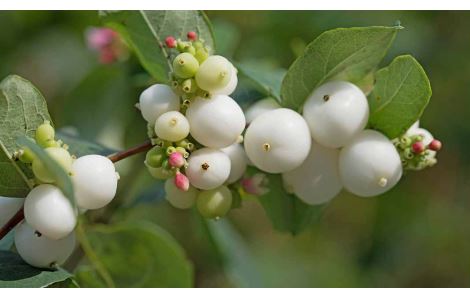
Shrubs with white berries add a unique aesthetic to gardens, bringing a serene, almost ethereal quality to landscapes, especially during the fall and winter months. These bushes can transform a garden with their clusters of white fruit, standing out against the backdrop of darker foliage or snow-covered branches, making them a focal point in seasonal displays. Their berries often persist through the colder seasons, providing not just visual interest but also a source of contrast and light in the garden.
White berries serve as a vital food source for various birds and other wildlife during times when other food might be scarce. This makes them an excellent choice for those interested in creating wildlife-friendly gardens, supporting local biodiversity by offering sustenance through the lean winter months. Additionally, the presence of these berries can attract a variety of bird species, enhancing the natural beauty and activity in the garden.
Shrubs with white berries can be used in numerous ways. They are perfect for adding to mixed borders where their berries provide a subtle yet striking contrast. They can be incorporated into winter gardens for their enduring appeal, or used in hedges where the white berries offer a refreshing change from the more common green, red, or black. Their versatility allows for both formal and informal garden styles, making them adaptable to different design needs while still contributing to the overall aesthetic and ecological balance of the garden.
Shrubs With White Berries
Snowberry (Symphoricarpos albus)
Native to North America, the Snowberry is a deciduous shrub that becomes one of the garden’s highlights in the fall with its dense clusters of white, waxy berries. These berries persist into winter, offering a stark contrast against the bare branches or snow, and are a favorite of birds.
Coralberry (Symphoricarpos orbiculatus)
Closely related to Snowberry, Coralberry from North America produces white berries that can sometimes take on a pinkish hue as they mature. It’s noted for its arching branches and dense berry clusters, making it an excellent choice for naturalistic landscapes or wildlife gardens.
White-Fruited Beautyberry (Callicarpa americana ‘Alba’)
A rare cultivar of the more common purple-fruited beautyberry, this one stands out with its white berries. The ‘Alba’ variety offers the same arching branches and late-season interest, but with a different color scheme, providing a unique aesthetic in the garden.
White Elderberry (Sambucus nigra ‘Eva’)
This cultivar of the common elderberry produces creamy white berries rather than the typical dark purple. ‘Eva’ is valued not only for its berries but also for its variegated foliage, adding year-round interest to any garden space.
White-Fruited Dogwood (Cornus alba ‘Sibirica Variegata’)
While known for its variegated leaves and red stems, this dogwood variety also produces small clusters of white berries in late summer to fall. These berries add to the plant’s ornamental appeal and are a food source for birds.
White-Fruited Viburnum (Viburnum tinus ‘Eve Price’)
This evergreen shrub from the Mediterranean region bears small, white berries following its pink-tinged flowers. ‘Eve Price’ is particularly valued for its dense, dark green foliage and its ability to flower in winter, followed by the white berries.
White-Flowered Serviceberry (Amelanchier canadensis ‘Rainbow Pillar’)
Though primarily known for its stunning fall foliage and early spring flowers, this serviceberry also bears small white berries. These berries are edible and sweet, attracting birds and providing a brief but beautiful white berry display.
White-Fruited Privet (Ligustrum obtusifolium ‘Variegatum’)
This variegated variety of privet produces white berries in the fall, contrasting with its green and white foliage. It’s commonly used in hedges or as an ornamental plant, where its berries add a subtle but charming element to the garden.
White-Fruited Hawthorn (Crataegus monogyna ‘Alba’)
This variety of the common hawthorn tree features white berries rather than the typical red. It’s an excellent choice for hedgerows, offering not only the white berries but also spring flowers and autumn foliage, contributing to biodiversity with its ability to attract wildlife.
White-Fruited Buckthorn (Rhamnus alaternus ‘Argenteovariegata’)
Known for its variegated leaves, this Mediterranean shrub also produces small white berries. It’s an evergreen, which means the berries can be seen throughout much of the year, providing winter interest and a food source for birds.
White-Fruited Holly (Ilex aquifolium ‘Argentea Marginata’)
A variegated holly with white berries, this cultivar is particularly striking due to its contrast between the dark green leaves edged in white and the bright white berries. It’s used for both ornamental purposes and as a wildlife-friendly plant in winter gardens.
White-Fruited Cranberrybush Viburnum (Viburnum opulus ‘Xanthocarpum’)
Unlike the more common red-fruited varieties, ‘Xanthocarpum’ produces clusters of white berries that are quite eye-catching, especially against the backdrop of its autumn foliage. This shrub is also known for its lacecap flowers in spring.
White-Fruited Chokeberry (Aronia melanocarpa ‘Brilliantissima’)
Although most chokeberries produce black berries, this cultivar has berries that start white and may turn slightly pink or red as they mature. It’s prized for its ornamental qualities, including its brilliant autumn leaf color.
White-Fruited Elder (Sambucus racemosa ‘Sutherland Gold’)
With golden foliage that provides a dramatic contrast, this elderberry variant produces clusters of white berries. It’s less common but offers a unique look in the garden with its bright leaves and white fruit.
White-Fruited Cotoneaster (Cotoneaster lacteus)
An evergreen shrub from China, this cotoneaster species produces white berries in large clusters. It’s often used for ground cover or in hedges, offering year-round interest with its foliage and winter berries.
White-Fruited Skimmia (Skimmia japonica ‘White Dwarf’)
This compact, evergreen shrub from Japan produces fragrant white flowers in spring followed by white berries in the fall, provided there’s a male plant nearby for pollination. It’s perfect for small gardens or containers, where its berries add a touch of winter interest.